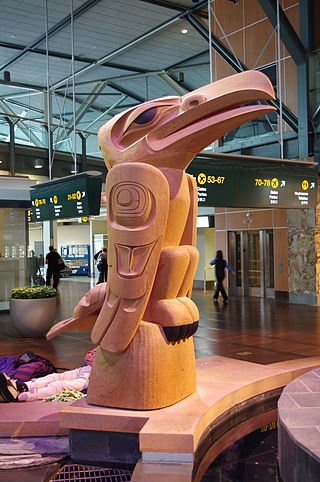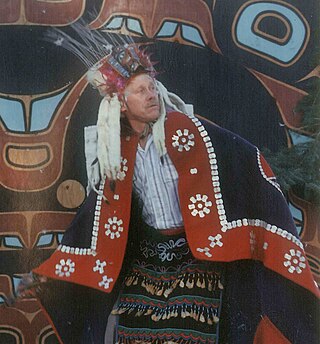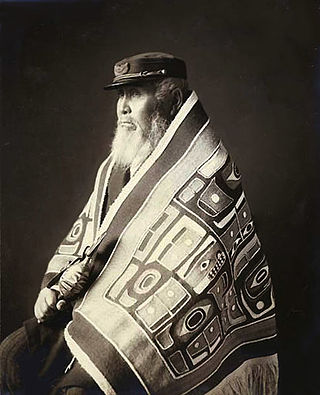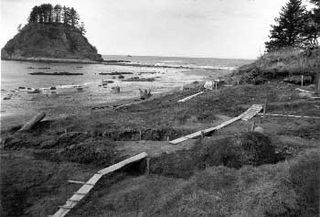Related Research Articles

Totem poles are monumental carvings found in western Canada and the northwestern United States. They are a type of Northwest Coast art, consisting of poles, posts or pillars, carved with symbols or figures. They are usually made from large trees, mostly western red cedar, by First Nations and Indigenous peoples of the Pacific Northwest Coast including northern Northwest Coast Haida, Tlingit, and Tsimshian communities in Southeast Alaska and British Columbia, Kwakwaka'wakw and Nuu-chah-nulth communities in southern British Columbia, and the Coast Salish communities in Washington and British Columbia.

The Makah are an Indigenous people of the Pacific Northwest Coast living in Washington, in the northwestern part of the continental United States. They are enrolled in the federally-recognized Makah Indian Tribe of the Makah Indian Reservation, commonly known as the Makah Tribe.

The Burke Museum of Natural History and Culture is a natural history museum in Seattle, Washington, in the United States. Established in 1899 as the Washington State Museum, it traces its origins to a high school naturalist club formed in 1879. The museum is the oldest in Washington state and boasts a collection of more than 16 million artifacts, including the world's largest collection of spread bird wings. Located on the campus of the University of Washington, the Burke Museum is the official state museum of Washington.

Aboriginal whaling or indigenous whaling is the hunting of whales by indigenous peoples recognised by either IWC or the hunting is considered as part of indigenous activity by the country. It is permitted under international regulation, but in some countries remains a contentious issue. It is usually considered part of the subsistence economy. In some places, whaling has been superseded by whale watching instead. This article deals with communities that continue to hunt; details about communities that have ended the practice may be found in History of whaling.

Makah Reservation is an Indian reservation of the Makah Native Americans located on the northwestern tip of the Olympic Peninsula in Clallam County, Washington, United States. The northern boundary of the reservation is the Strait of Juan de Fuca. The western boundary is the Pacific Ocean. It has a land area of 121.451 square kilometres (46.892 sq mi) and a 2000 census resident population of 1,356 persons. Its largest community is Neah Bay.

Dempsey Bob, is a Northwest Coast woodcarver and sculptor from British Columbia, Canada, who is of Tahltan and Tlingit First Nations descent. He was born in the Tahltan village of Telegraph Creek on the Stikine River in northwestern B.C., and is of the Wolf clan.

Oscar William Holm Jr. was an American art historian and author, focused on Indigenous Northwest Coast art. He created artworks and taught Northwest Coast style, including formline design. He was Professor Emeritus of Art History, and Curator Emeritus of Northwest Coast Indian Art at the Burke Museum of Natural History and Culture and occasionally lectured at the University of Washington in Seattle.
Walter Harris, also known as Simogyet Geel, was a Canadian artist and hereditary chief from the Gitxsan (Gitksan) First Nation in northwestern British Columbia.

Northwest Coast art is the term commonly applied to a style of art created primarily by artists from Tlingit, Haida, Heiltsuk, Nuxalk, Tsimshian, Kwakwaka'wakw, Nuu-chah-nulth and other First Nations and Native American tribes of the Northwest Coast of North America, from pre-European-contact times up to the present.

The Indigenous peoples of the Pacific Northwest Coast are composed of many nations and tribal affiliations, each with distinctive cultural and political identities. They share certain beliefs, traditions and practices, such as the centrality of salmon as a resource and spiritual symbol, and many cultivation and subsistence practices. The term Northwest Coast or North West Coast is used in anthropology to refer to the groups of Indigenous people residing along the coast of what is now called British Columbia, Washington State, parts of Alaska, Oregon, and Northern California. The term Pacific Northwest is largely used in the American context.

The Ozette Native American Village Archeological Site is the site of an archaeological excavation on the Olympic Peninsula near Neah Bay, Washington, United States. The site was a village occupied by the Ozette Makah people until a mudslide inundated the site around the year 1750. It is located in the now unpopulated Ozette Native American Reservation.
Preston Singletary is a Native American glass artist.
Willie Seaweed was a Kwakwaka'wakw chief and wood carver from Canada. He was considered a master Northwest Coast Indian artist who is remembered for his technical artistic style and protection of traditional native ceremonies during the Canadian potlatch ceremony ban. Today, Seaweed's work can be found in cultural centers and corporations, art museums, natural history museums, and private collections. Some pieces are still in use by the Nak'waxda'xw tribe.

A transformation mask, also known as an opening mask, is a type of mask used by indigenous people of the Northwest Coast and Alaska in ritual dances. These masks usually depict an outer, animal visage, which the performer can open by pulling a string to reveal an inner human face carved in wood to symbolize the wearer moving from the natural world to a supernatural realm. Northwest coast peoples generally use them in potlatches to illustrate myths, while they are used by Alaska natives for shamanic rituals.
Robert James "Jim" Schoppert was an Tlingit Alaska Native artist and educator. His work includes woodcarving, painting, poetry, and essays. He has been described as an innovator, whose works pushed the boundaries of what was expected from Northwest Coast art.
Edward Eugene Claplanhoo was an American Makah elder and former chairman of the Makah Tribe, located on the northwest tip of the Olympic Peninsula in Washington state. Claplanhoo was the first Makah to earn a bachelor's degree. Claplanhoo was the chairman of the Makah during the excavation of the Ozette Indian Village Archeological Site in the 1970s. He is credited with keeping the artifacts uncovered at Ozette in Neah Bay. Under his leadership, the Makah Museum, which houses the Ozette collection, was established at Neah Bay in 1979. He also established Fort Núñez Gaona–Diah Veterans Park in Neah Bay in 2008.

Marianne Nicolson is a Dzawada’enuxw visual artist whose work explores the margins at which public access to First Nations artifacts clashes with the preservation of indigenous cultural knowledge. She utilizes painting, photography, mixed-media, sculpture, and installation to create modern depictions of traditional Kwakwaka’wakw beliefs, and has exhibited in Canada and throughout the world since 1992.

The Ozette, also known locally as Makah Ozette or Anna Cheeka's Ozette is the oldest variety of potato grown in the Pacific Northwest region. This potato, of the petite heirloom fingerling type, was grown for over two centuries by the Makah tribe native to Washington and was "rediscovered" in the late 1980s.

Whaling on the Pacific Northwest Coast encompasses both aboriginal and commercial whaling from Washington State through British Columbia to Alaska. The indigenous peoples of the Pacific Northwest Coast have whaling traditions dating back millennia, and the hunting of cetaceans continues by Alaska Natives and to a lesser extent by the Makah people.
Marvin Oliver (1946–2019) was an Indigenous American artist and professor. He mainly focused on contemporary sculpture and printmaking. Oliver used his Quinault and Isleta-Pueblo heritage as an influence for his art, but he also took inspiration from Coast Salish traditions.
References
- 1 2 "Greg Colfax". art.seattleartmuseum.org. Retrieved 18 May 2022.
- 1 2 "Greg Colfax". art.state.gov. Retrieved 18 May 2022.
- ↑ Hege Piatote, Beth (1998-10-31). "Fighting for Native Rites: Renewal of the Makah Whale Hunt - ProQuest". Native Americas. XV.
- 1 2 "Andy Wilbur-Peterson and Greg Colfax". arts.wa.gov. Retrieved 18 May 2022.
- ↑ Davy, Jack (2021-10-01). So Much More Than Art: Indigenous Miniatures of the Pacific Northwest. UBC Press. pp. 25, 29. ISBN 978-0-7748-6658-3.
- ↑ Lubow, Arthur (5 May 2022). "Museum of Natural History's Renewed Hall Holds Treasures and Pain". The New York Times . Retrieved 18 May 2022.
- ↑ "Northwest Coast Hall".